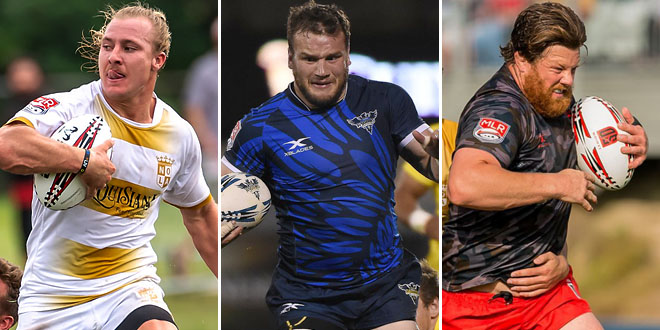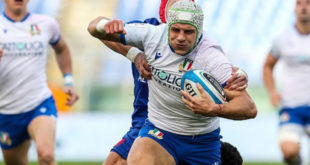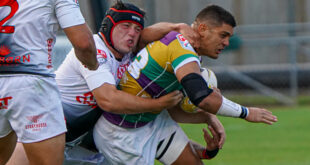The second Major League Rugby season was twice as long as the first and welcomed two new teams to the fray. It also saw the arrival of several high profile imports, while lesser-known arrivals were given a chance to show what other sides have been missing out on. Our second MLR Dream Team was not easy work with so much quality on display in Year Two.
There are some interesting notes about this year’s selection. Not one player from last year’s team made the grade. In fact only one of last year’s side got an honorable mention this year, and only one of this year’s team was in the final discussions last year. It’s the sign of a rapidly evolving league. How might the match go between the 2018 Dream Team and 2019?
Numbers-wise there were 11 players eligible for the USA or Canada last year. This year that number has dropped slightly to 9. It’s not a huge gap but a small indication of the impact that new players from abroad are having. How might that change next season?
In terms of team representation, the finalists – Seattle and San Diego – each contribute four players. Semi Finalists Toronto and New York have two players each chosen, with singles donated by New Orleans, Glendale, and Utah. Our sincere apologies to Texas.
1 – Rob Brouwer (Toronto Arrows) The front row is the domain of many a rugby cliché – the grizzled warrior, the crafty veteran, the master of the dark arts. Occasionally, it also runs across a late bloomer. Brouwer took up rugby in his senior year at high school, wasn’t a starter with his club side until into his 20s, and his first forays into provincial rugby were as a lock. His test debut came in 2016 at the age of 33 and one could be forgiven for thinking it would be a short stay at the top, yet here we are in 2019 and Brouwer, now 36, is playing the best rugby of his career. While not quite at the top in the scrum department, elsewhere he was exceptional. Brouwer’s dominant tackle count was among the best in MLR. Only three props played more minutes over the season, one of them his closest competitor at loosehead – New York’s James Rochford.
2 – Dylan Fawsitt (Rugby United New York) The position with the most contenders. Almost every team had a standout at hooker, and their try-scoring feats as a collective were remarkable. Leading the way was Fawsitt, who finished tied with John Ryberg on a baker’s dozen. As he did with Glendale last season, Fawsitt also spent time in the back row and may require an asterisk next to his name as the front rower with the most minutes played. New York’s driving maul was the most effective scoring tactic across the league and a significant part of that can be attributed to Fawsitt. Among several in the mix were NOLA captain Eric Howard, Seattle’s Stephan Coetzee, and the indispensable Pat O’Toole at Houston.
3 – Paddy Ryan (San Diego Legion) This was an easy choice, though the question may have been East Coast or West Coast? His namesake in New York also enjoyed a fine season while Toronto’s Morgan Mitchell was a delightful instrument of chaos. San Diego’s Ryan lived up to his Super Rugby hype and then some. His ball carrying, tackling, and scrum work were all of the highest order. Ryan even fit in the odd miss-pass just to mix things up. He had some honest competition but in our estimation the Australian was a step above the rest.
4 – Mike Sheppard (Toronto Arrows) Our left lock spot is normally reserved for a tall, agile lineout specialist. Think Ben Mitchell, last year’s selection, who was again consistently Austin’s best. This year we had no choice but to consider a different style – the destructive talents of Toronto’s bearded talisman. Sheppard came back from an underwhelming Americas Rugby Championship with a point to prove, and he did just that. Whenever inspiration was needed, be it a thumping tackle or hard yards from a ruck, look no further. His outstanding form has pushed him back into the World Cup reckoning.
5 – Brad Tucker (Seattle Seawolves) On the right side we like grunt, which would seem like the place for Sheppard but the Arrows had a behemoth in Paul Ciulini to fill that role. It was two Eagles veterans who gave pause for thought here. New York Nate, Brakeley that is, was a force in all aspects of play while Sweet Lou, of the San Diego Stanfill variety, came back from self-imposed exile to teach the youngsters the meaning of grind. Tucker was a wrecking ball going forward and a fearsome tackler in defense. Athletic in the lineout, strong in the scrum, and equally happy on the blindside flank. His offloading ability gave the Seawolves an extra dimension on attack and he contributed 7 tries himself.
6 – Lance Williams (Utah Warriors) The most transient position in MLR with many teams experimenting. We could have opted to pick Tucker here and name another lock, but the immense work rate of Williams was impossible to ignore. He somehow started every game and played 92% of all possible minutes, which would have been even higher were it not for three yellow cards. Only a half-dozen forwards across the league appeared more frequently. The ubiquitous Williams ran himself into the ground and had to be carried off when replaced. An exemplary Warrior.
7 – Nakai Penny (Seattle Seawolves) It took some time for Seattle to figure out what they were doing on the openside flank after Vili Toluta’u was injured. After experimenting with Tucker, Eric Duechle, and Aladdin Schirmer, Penny finally got the call to start against Utah and was henceforth an automatic selection. His playing time before that had been limited by a well-earned debut for Canada, and his form in the last 10 games of the season suggests he will have many more opportunities on the international stage in the years ahead. Athletic and supremely fit, Penny’s commitment in defense is second to none. He created two key turnovers in the MLR Final to keep Seattle in the race.
8 – Ross Deacon (Rugby United New York) A position sure to be debated with the main competition coming from Seattle pack leader Riekert Hattingh. It was by no means an easy decision, particularly after Seattle’s win on the weekend. Hattingh was a huge figure in the side, but the difference in the New York team when Deacon wasn’t at the back of the scrum was stark. His control at the base and carrying strength got them over the gainline on countless occasions. It wasn’t just power either, Deacon brought a subtle offloading quality and was also surprisingly effective in the lineout. A close call, but New York’s finest takes the honors by a whisker.
9 – Nate Augspurger (San Diego Legion) Another likely to be hotly debated with no clear and obvious winner. Augspurger would not have been at the top of the list prior to the season, in fact many pegged Nick Boyer as the Legion’s probable starter, and he was for the first four games. San Diego’s ‘other’ Eagles halfback got his chance against Austin and held his place for the rest of the season, forcing Boyer to the wing. There are still wrinkles in Augspurger’s game at scrumhalf but he has an ability to make something out of nothing and is pound-for-pound possibly the toughest tackler in MLR. Holden Yungert will be favored by some after another quality campaign for NOLA, while Mike Petri turned back the clock to lead RUNY into the Semi Finals.
10 – Joe Pietersen (San Diego Legion) No debate required. Pietersen was in a class of his own, a runaway winner of Player of the Year though post-season awards have yet to be unveiled. Provided an array of attacking options at any given moment, whether passing, running, or kicking. Made space for his outside backs, plugged the corners, slipped through gaps, and very nearly captained the side to the title. Second only to Brock Staller in points scoring. Pietersen’s picture-perfect drop goal in the dying moments of the Championship Final might have sealed the deal on any other day.
11 – John Ryberg (Glendale Raptors) Appropriately dubbed by Dan Power as the ‘bicep with eyeballs’, Ryberg left a trail of destruction in his wake as he racked up 13 tries in the regular season. That mark stood alone until Fawsitt matched him in the Semi Final, though the method the two chiefly employed was radically different. Ryberg scored or gave the final pass on nearly 40% of Glendale’s tries this season. Previously a football player, the 27-year-old only turned to rugby six years ago and has adapted quickly. Few if any others league-wide caused as much distress – the calls of ‘watch Ryberg!’ from opponents could be heard from the field during broadcasts. They knew he was coming… and still he succeeded.
12 – JP du Plessis (San Diego Legion) Gave a strong impression of himself in 2018 but his season was cut short by injury. This year he was a fixture in the Legion side, missing only one game. du Plessis was the go-to man on first phase to breach the gainline, doing so with his hard-running style but also using footwork effectively to slide into half-gaps. Defensively he was as strong as they come, like an extra loose forward guarding the midfield. du Plessis was also a finisher, scoring 7 tries often on his second or even third touch of an attacking move. Runner-up was another South African – Glendale’s outstanding Robbie Petzer, who set a single-game scoring record with an incredible 34 points against Utah.
13 – Tristan Blewett (NOLA Gold) In the running with Ryan and Tucker for best signing of the off-season. Started five games on the wing, and even spent a few minutes at fullback in the season finale against San Diego. It was at outside center where he was most effective. A smaller center by modern standards, Blewett’s explosive acceleration took him out of harm’s way and sometimes all the way to the tryline. He scored 12 tries himself and created many more for others. Blewett’s work rate off the ball was impressive, be it chasing kicks or tracking back to make cover tackles. Halfway through the season he was already a favorite for the Dream Team, by the end he was a certainty.
14 – Brock Staller (Seattle Seawolves) The left wing was Ryberg’s by a landslide and the right came down to a pair of Canadians. Dan Moor spent some time at outside center during the early part of the season but settled in on the wing at the end. He was outstanding as Toronto’s captain with his overall contribution making him a strong candidate. In the end we couldn’t deny the league’s top scorer. Staller was an unrivaled points machine, outscoring Pietersen by 60… an incredible feat. He wasn’t just a pretty boy on the wing either, often popping up as a crash ball option from a ruck or in the case of the MLR Final – joining in on the winning maul. Every team needs a metronome. Ours has two.
15 – Mat Turner (Seattle Seawolves) Fullback is a vital position for any team and there was no shortage of quality to pick from. JP Eloff played almost every minute for NOLA with his vision and style an integral component of their attack. If we want to talk pure entertainment value, Glendale’s Dylan Taikato-Simpson was a human highlight reel. Turner was our runner-up last season but all things considered was a cut above this time. At 31 years old he still has plenty of pace, as evidenced by his 8 tries, and there was no better defender at the back. The Seawolves are a different team when Turner is on the field. If we were asked to name the best MLR player over its two seasons, he would be on the shortlist.
 Americas Rugby News Rugby news from across the Americas!
Americas Rugby News Rugby news from across the Americas!




